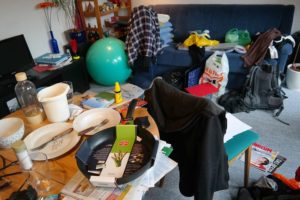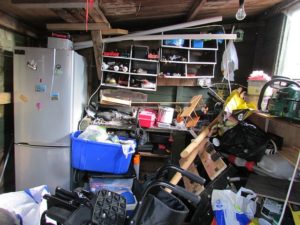 I have a confession to make. I keep a lot of stuff – things that may come in handy “someday.” But in truth, the majority of my possessions are rarely, if ever, used. And I’m not alone. Americans like to shop for, receive, own, collect, display, and store things. And when we tire of the things we own, we get new things.
I have a confession to make. I keep a lot of stuff – things that may come in handy “someday.” But in truth, the majority of my possessions are rarely, if ever, used. And I’m not alone. Americans like to shop for, receive, own, collect, display, and store things. And when we tire of the things we own, we get new things.
In the 1950’s the average size of the American home was less than 1,000 square feet. It’s now grown to over 2,500 and most of us fill own homes with items of all sizes, shapes, and levels of practicality. Occasionally, we give our things away or sell them, but more often we find a place to store our ever growing collection of material possessions. And even with this additional space, our possessions tend to outgrow our homes. As a result, we tend to look elsewhere for a place to store our things, which brings us to the option of self-storage. In fact, over the past forty years, the self-storage industry in the United States has been the fastest growing segment of the commercial real estate industry. Ohio ranks 5th in the nation with more than 1,800 self-storage facilities.
A team of University of California anthropologists studied 32 middle-class American families. The researchers studied how living environments were used and how people interacted with their material things. In addition, the researchers counted every single thing owned by each family, and asked why things were purchased and saved. Some common findings included:
– Except for the master bedroom, toys were in every room of the house, creating a child-focused living environment. The study shared that the U.S. has 3.1% of the world’s children, but consumes 40% of the world’s toys.
– Convenience foods, such as frozen ready-to-microwave meals or shelf-safe snack foods, were plentiful and required additional storage in a room other than the kitchen. Because of this, a second refrigerator in the garage or basement was common.
Hyper consumerism was evident in the cluttered storage spaces found throughout the houses and storage buildings. In fact, it was determined that contemporary U.S. households have more material possessions than any other society in global recorded history.
Researchers were also able to document that the cluttered environments created significant stress for the families, especially for mothers. Women were more likely to remark on the clutter and mention being burdened by the number of things that crowded their homes. It was found that these women showed increased levels of the stress hormone cortisol.
If any of this sounds as though its hitting “close to home,” remember that you have a choice. Start this new year by thinking about your family’s possessions and mindfully plan how and when to be rid of them. Look around your house and ask yourself where you got each thing you see and when it was last used. Get rid of everything that is no longer used or appreciated before your material possessions begin robbing you of comfort and joy in your own home.
If you’re interested in reading more of the study detailed in this post, ‘A Cluttered Life: Middle-Class Abundance’ it can be viewed online.

